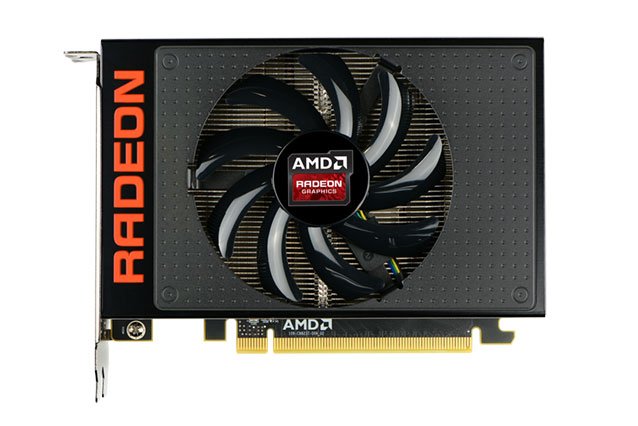


Back in June of this year, AMD launched a new flagship graphics card. Based on their new "Fiji" architecture, the Radeon R9 Fury X was also the first to hit the market with 3D-stacked, high-performance memory called High-Bandwidth Memory (HBM). Now AMD has revealed more information on its younger brother, the equally equipped Radeon R9 Nano, and the company is set to redefine what small means.
The Radeon R9 Nano is a mini-ITX graphics card. Measuring at only 6.7 inches x 6.7 inches, it's 40% shorter than the R9 290X. Conventional mITX systems, however, tend to run hot, loud, and on power supplies that don't have the same capacity as those found in larger desktop setups. As a result, they haven't been considered for high-end gaming at resolutions up to 4K. Big performance needs a big chasis. It's that traditional wisdom that the R9 Nano has been built to challenge.
For starters, the R9 Nano utilizes a full-blown Fury X GPU on its board. Both cards share a 28nm architecture, 4GB of High-Bandwidth Memory, 4096 stream processors, 512 GB/s memory bandwidth, and a similar clock rate of up to 1000 MHz. According to AMD's benchmarks, that translates to a 30% performance gain over the Nvidia GTX 970 mITX and last generation's R9 290X.
Continuing with the industrial quality of the R9 Fury X, the R9 Nano sports a black, full-metal shroud and brushed aluminum finish for its exoskeleton. Three DisplayPort outputs and one HDMI output are housed on its side plate. The PCB is correspondingly matte black for a consistent, sleek presentation.
Another set of factors that places the R9 Nano in a class of its own is its energy efficiency and heat management. The card only requires a single 8-pin PCIe power connection. It uses 30% less power than the R9 290X, operating with a typical TPD of 175 watts. Meanwhile, a full PCB tray cools its components and, for the first time in their reference design, it features a dedicated heat pipe cooler just for the voltage regulator. Underneath, completely flat heat pipes allow it to fit an even larger air cooling solution. That and more put it in a temperature range similar to the R9 Fury X. It maintains a 75 degree Celsius operating temperature, 20 degrees cooler than where AMD was two years ago, and won't throttle until reaching 85 degrees.
AMD has designed the R9 Nano to hold the company's flagship position alongside the R9 Fury X. It offers 90% the performance of its bigger brother but without the 50% power penalty, exciting numbers from something so compact. Enthusiast builders will be able to achieve the same high benchmarks in 4K gaming seen in their towering machines but in a smaller chassis. AMD has described it as a hint of what's to come, an "evolution of the gaming PC," but it's not an evolution we have to wait long for. The R9 Nano will launch this September 12 with a retail price of $649.





 Top 5 Most Wanted FPS Reboots
Top 5 Most Wanted FPS Reboots Trove: Neon Nightsky Wings Crafting Guide
Trove: Neon Nightsky Wings Crafting Guide Might & Magic 3 Heroes - HD Edition (PC) review
Might & Magic 3 Heroes - HD Edition (PC) review Dropsy - complete guide ( PC / Mac / Linux)
Dropsy - complete guide ( PC / Mac / Linux) H1Z1 Guide: How to Get Started
H1Z1 Guide: How to Get Started